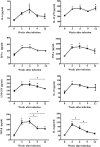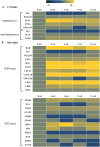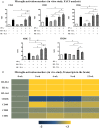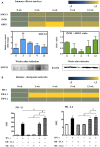Characteristics of Infection Immunity Regulated by Toxoplasma gondii to Maintain Chronic Infection in the Brain
- PMID: 29459868
- PMCID: PMC5807351
- DOI: 10.3389/fimmu.2018.00158
Characteristics of Infection Immunity Regulated by Toxoplasma gondii to Maintain Chronic Infection in the Brain
Abstract
To examine the immune environment of chronic Toxoplasma gondii infection in the brain, the characteristics of infection-immunity (premunition) in infection with T. gondii strain ME49 were investigated for 12 weeks postinfection (PI). The results showed that neuronal cell death, microglia infiltration and activation, inflammatory and anti-inflammatory cytokine expression, Stat1 phosphorylation, and microglia activation and inflammatory gene transcripts related to M1 polarization in the brain were increased during the acute infection (AI) stage (within 6 weeks PI), suggesting that innate and cellular inflammatory response activation and neurodegeneration contributed to excessive inflammatory responses. However, these immune responses decreased during the chronic infection (CI) stage (over 6 weeks PI) with reductions in phosphorylated STAT1 (pSTAT1) and eosinophilic neurons. Notably, increases were observed in transcripts of T-cell exhaustion markers (TIM3, LAG3, KLRG1, etc.), suppressor of cytokines signaling 1 protein (SOCS1), inhibitory checkpoint molecules (PD-1 and PD-L1), and Arg1 from the AI stage (3 weeks PI), implying active immune intervention under the immune environment of M1 polarization of microglia and increases in inflammatory cytokine levels. However, when BV-2 microglia were stimulated with T. gondii lysate antigens (strain RH or ME49) in vitro, nitrite production increased and urea production decreased. Furthermore, when BV-2 cells were infected by T. gondii tachyzoites (strain RH or ME49) in vitro, nitric oxide synthase and COX-2 levels decreased, whereas Arg1 levels significantly increased. Moreover, Arg1 expression was higher in ME49 infection than in RH infection, whereas nitrite production was lower in ME49 infection than in RH infection. Accordingly, these results strongly suggest that immune triggering of T. gondii antigens induces M1 polarization and activation of microglia as well as increase NO production, whereas T. gondii infection induces the inhibition of harmful inflammatory responses, even with M1 polarization and activation of microglia and Th1 inflammatory responses, suggesting a host-parasite relationship through immune regulation during CI. This is a characteristic of infection immunity in infection with T. gondii in the central nervous system, and SOCS1, a negative regulator of toxoplasmic encephalitis, may play a role in the increase in Arg1 levels to suppress NO production.
Keywords: Toxoplasma gondii; brain; chronic infection; infection immunity; microglial polarization.
Figures









Similar articles
-
Galectin-3 and Galectin-9 May Differently Regulate the Expressions of Microglial M1/M2 Markers and T Helper 1/Th2 Cytokines in the Brains of Genetically Susceptible C57BL/6 and Resistant BALB/c Mice Following Peroral Infection With Toxoplasma gondii.Front Immunol. 2018 Jul 31;9:1648. doi: 10.3389/fimmu.2018.01648. eCollection 2018. Front Immunol. 2018. PMID: 30108583 Free PMC article.
-
[Rudolf-Virchow Prize 1998. Award lecture. Toxoplasmosis: a model infection for studying systemic and intracerebral immune reactions].Verh Dtsch Ges Pathol. 1998;82:9-22. Verh Dtsch Ges Pathol. 1998. PMID: 10095413 German.
-
Dectin-1-CD37 association regulates IL-6 expression during Toxoplasma gondii infection.Parasitol Res. 2014 Aug;113(8):2851-60. doi: 10.1007/s00436-014-3946-1. Epub 2014 May 29. Parasitol Res. 2014. PMID: 24870248
-
Persistence of Toxoplasma gondii in the central nervous system: a fine-tuned balance between the parasite, the brain and the immune system.Parasite Immunol. 2015 Mar;37(3):150-8. doi: 10.1111/pim.12173. Parasite Immunol. 2015. PMID: 25573476 Review.
-
Effects of Toxoplasma gondii infection on the brain.Schizophr Bull. 2007 May;33(3):745-51. doi: 10.1093/schbul/sbm008. Epub 2007 Feb 23. Schizophr Bull. 2007. PMID: 17322557 Free PMC article. Review.
Cited by
-
Contrasting Disease Progression, Microglia Reactivity, Tolerance, and Resistance to Toxoplasma gondii Infection in Two Mouse Strains.Biomedicines. 2024 Jun 26;12(7):1420. doi: 10.3390/biomedicines12071420. Biomedicines. 2024. PMID: 39061995 Free PMC article.
-
Behavioral and Neuropathological Changes After Toxoplasma gondii Ocular Conjunctival Infection in BALB/c Mice.Front Cell Infect Microbiol. 2022 Mar 9;12:812152. doi: 10.3389/fcimb.2022.812152. eCollection 2022. Front Cell Infect Microbiol. 2022. PMID: 35372100 Free PMC article.
-
Altered landscape of total RNA, tRNA and sncRNA modifications in the liver and spleen of mice infected by Toxoplasma gondii.PLoS Negl Trop Dis. 2024 Jun 21;18(6):e0012281. doi: 10.1371/journal.pntd.0012281. eCollection 2024 Jun. PLoS Negl Trop Dis. 2024. PMID: 38905319 Free PMC article.
-
Exosomal miRNA-21 from Toxoplasma gondii-infected microglial cells induces the growth of U87 glioma cells by inhibiting tumor suppressor genes.Sci Rep. 2022 Sep 30;12(1):16450. doi: 10.1038/s41598-022-20281-w. Sci Rep. 2022. PMID: 36180486 Free PMC article.
-
Catastrophic consequences: can the feline parasite Toxoplasma gondii prompt the purrfect neuroinflammatory storm following traumatic brain injury?J Neuroinflammation. 2020 Jul 25;17(1):222. doi: 10.1186/s12974-020-01885-3. J Neuroinflammation. 2020. PMID: 32711529 Free PMC article. Review.
References
-
- Rozenfeld C, Martinez R, Seabra S, Sant’anna C, Goncalves JG, Bozza M, et al. Toxoplasma gondii prevents neuron degeneration by interferon-gamma-activated microglia in a mechanism involving inhibition of inducible nitric oxide synthase and transforming growth factor-beta1 production by infected microglia. Am J Pathol (2005) 167:1021–31.10.1016/S0002-9440(10)61191-1 - DOI - PMC - PubMed
Publication types
MeSH terms
Substances
LinkOut - more resources
Full Text Sources
Other Literature Sources
Research Materials
Miscellaneous

